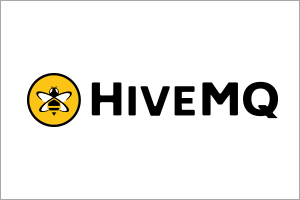About HiveMQ
Founded in 2013 in Landshut, Germany, by Christian Goetz and Dominik Obermaier. HiveMQ set out to make it easier to build secure messaging-based machine to machine applications using the MQTT lightweight messaging protocol, which IBM had open sourced that same year. Designed by IBM Master Inventor Andy Stanford-Clark, MQTT was born of a project to monitor oil pipelines in 1999. MQTT has become the defacto standard for Internet of Things (IoT) apps requiring reliability and persistence.
HiveMQ builds products on MQTT, monetising functions for development, monitoring, and observability tooling.
Size
The company is self-funded and currently employs 30 people. It has 120+ customers.
Products
HiveMQ MQTT Platform includes an MQTT broker, extension development kit and control center, with three versions – Pro, Enterprise and Community. Features include:
- A masterless architecture – all nodes are the same – allows elastic scaling. HiveMQ claims it can support up to 10 million simultaneous connections
- Real-time monitoring dashboard
- Connection handling for multiple cloud or on-premises environments
- Kafka support for customers that want to integrate MQTT endpoints with Kafka streaming.
HiveMQ Cloud – a hosted managed service version of the broker and enterprise management tools. Hourly pricing for managing IoT device connections to the cloud.
HiveMQ Marketplace = a library of extensions for functions such as Role-based Access Control (RBAC) and third party integrations with other Apache licensed tools such as Prometheus for monitoring and InfluxDB for time series analysis.
Projects
The company follows an open core model and offers the MQTT broker project as an open source offering. The company has two main open source projects, under the Apache 2 License.
HiveMQ Community Edition (CE) = a Java-based implementation of the MQTT 3.x and MQTT5 broker spec.
HiveMQ MQTT Client – a Java library that implements the MQTT 3.1.1 and MQTT 5 specification. Developed in collaboration with BMW Car IT, with a focus on low memory, power and CPU consumption.
Go to Market
IoT is a vertical industry play, and HiveMQ’s key markets are those that are strong in its home market – for example automotive and process manufacturing. German companies are investing heavily in “Industry 4.0” – the country’s catchall term for IoT-driven digital transformation in engineering and manufacturing. Sectors include Automotive, Connected OEM products and Consumer electronics
HiveMQ customers are generally enterprise brands that are trying to build connected devices and connected experiences, or are trying to improve customer experiences. The target customer is an architect or developer, for a practitioner led sale. HiveMQ is primarily product-driven but does offer some consulting services to help get customer proof of concept (POC) projects off the ground.
German companies generally prefer to do business with other German companies, or those with a strong local presence. The German automotive industry is under severe pressure, notably from Tesla at the top end of the market, but has also been facing other headwinds, with the rise of Uber in global markets and pay-per-use business models. BWW and Daimler AG, for example, are therefore collaborating on Car2Go, a pay-as-you-go model for car sharing – just install the app and go. All automotive companies are pursuing Connected Car strategies. HiveMQ has an extremely aggressive target – to see 50% of connected cars using HiveMQ within three years. It will be interesting to see what effect COVID-19 has – we expect acceleration of digital transformation efforts in all sectors and automotive is no different. Existing automotive customers include Audi, BMW, Daimler, eCarX, and Tesla.
On the Connected products side HiveMQ customers include Siemens, Honeywell, and Wilterhalter (industrial dish washing).
HiveMQ also competes with proprietary plant automation solutions in manufacturing. The MQTT client is designed for these edge deployments, for example in factory floor settings. The company’s IoT Observability platform is useful here. IoT is almost by definition a distributed network of black boxes, which creates specific challenges.
Competitive Landscape
The major cloud providers see IoT as their natural domain, as they build out from cloud to edge environments, with messaging as the primary model for building large scale event driven systems. HiveMQ has therefore ended up competing head on with some of the most formidable players in the industry – namely AWS and and MS Azure. At the same time, however, most HiveMQ deployments are on those platforms. IBM also offers a hosted IoT platform with MQTT support. Google Cloud also supports MQTT clients. HiveMQ plans to position itself as a multi-cloud alternative, selling portability and avoidance of lock-in.
As noted above, automotive, particularly in the German and neighboring markets can be a good springboard. Kubernetes, though, is beginning to make an impact in Connected Car systems – for example at Toyota Connected. BMW is a major Red Hat OpenShift customer. Mercedes-Benz is running Kubernetes on Microsoft Azure, using Hashicorp Consul for service discovery.
It’s also worth mentioning another open source implementation of the MQTT spec – Eclipse Mosquitto is a broker with Paho being the client.
In conclusion HiveMQ has both technology shifts and computing model shifts to navigate, with major competitors on all sides, but it’s a small company with an impressive customer base, which continues to build useful tools and deepen customer relationships.
Disclaimer: HiveMQ is a RedMonk client, but this is not a commissioned piece of research and the company had no editorial control over the content. AWS, Hashicorp, IBM, Microsoft and Red Hat are also RedMonk clients.

No Comments